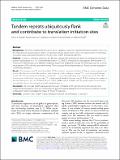Files in this item
Tandem repeats ubiquitously flank and contribute to translation initiation sites
Item metadata
| dc.contributor.author | Maddi, Ali M. A. | |
| dc.contributor.author | Kavousi, Kaveh | |
| dc.contributor.author | Arabfard, Masoud | |
| dc.contributor.author | Ohadi, Hamid | |
| dc.contributor.author | Ohadi, Mina | |
| dc.date.accessioned | 2022-07-28T12:30:13Z | |
| dc.date.available | 2022-07-28T12:30:13Z | |
| dc.date.issued | 2022-07-27 | |
| dc.identifier | 280644519 | |
| dc.identifier | 30b85281-cb6e-4307-9700-2165a7b1242c | |
| dc.identifier | 000831232300001 | |
| dc.identifier | 85135019259 | |
| dc.identifier.citation | Maddi , A M A , Kavousi , K , Arabfard , M , Ohadi , H & Ohadi , M 2022 , ' Tandem repeats ubiquitously flank and contribute to translation initiation sites ' , BMC Genomic Data , vol. 23 , 59 . https://doi.org/10.1186/s12863-022-01075-5 | en |
| dc.identifier.issn | 2730-6844 | |
| dc.identifier.other | RIS: urn:5F9966CA4EACB486527FBF34D6B56B2E | |
| dc.identifier.other | RIS: Maddi2022 | |
| dc.identifier.other | ORCID: /0000-0001-6418-111X/work/116597659 | |
| dc.identifier.uri | https://hdl.handle.net/10023/25740 | |
| dc.description.abstract | Background While the evolutionary divergence of cis-regulatory sequences impacts translation initiation sites (TISs), the implication of tandem repeats (TRs) in TIS selection remains largely elusive. Here, we employed the TIS homology concept to study a possible link between TRs of all core lengths and repeats with TISs. Methods Human, as reference sequence, and 83 other species were selected, and data was extracted on the entire protein-coding genes (n = 1,611,368) and transcripts (n = 2,730,515) annotated for those species from Ensembl 102. Following TIS identification, two different weighing vectors were employed to assign TIS homology, and the co-occurrence pattern of TISs with the upstream flanking TRs was studied in the selected species. The results were assessed in 10-fold cross-validation. Results On average, every TIS was flanked by 1.19 TRs of various categories within its 120 bp upstream sequence, per species. We detected statistically significant enrichment of non-homologous human TISs co-occurring with human-specific TRs. On the contrary, homologous human TISs co-occurred significantly with non-human-specific TRs. 2991 human genes had at least one transcript, TIS of which was flanked by a human-specific TR. Text mining of a number of the identified genes, such as CACNA1A, EIF5AL1, FOXK1, GABRB2, MYH2, SLC6A8, and TTN, yielded predominant expression and functions in the human brain and/or skeletal muscle. Conclusion We conclude that TRs ubiquitously flank and contribute to TIS selection at the trans-species level. Future functional analyses, such as a combination of genome editing strategies and in vitro protein synthesis may be employed to further investigate the impact of TRs on TIS selection. | |
| dc.format.extent | 11 | |
| dc.format.extent | 4468673 | |
| dc.language.iso | eng | |
| dc.relation.ispartof | BMC Genomic Data | en |
| dc.subject | Genome-scale | en |
| dc.subject | Tandem repeat | en |
| dc.subject | Translation initiation site | en |
| dc.subject | Homology | en |
| dc.subject | TIS selection | en |
| dc.subject | QH426 Genetics | en |
| dc.subject | DAS | en |
| dc.subject.lcc | QH426 | en |
| dc.title | Tandem repeats ubiquitously flank and contribute to translation initiation sites | en |
| dc.type | Journal article | en |
| dc.contributor.institution | University of St Andrews. School of Physics and Astronomy | en |
| dc.contributor.institution | University of St Andrews. Centre for Designer Quantum Materials | en |
| dc.identifier.doi | 10.1186/s12863-022-01075-5 | |
| dc.description.status | Peer reviewed | en |
This item appears in the following Collection(s)
Items in the St Andrews Research Repository are protected by copyright, with all rights reserved, unless otherwise indicated.

